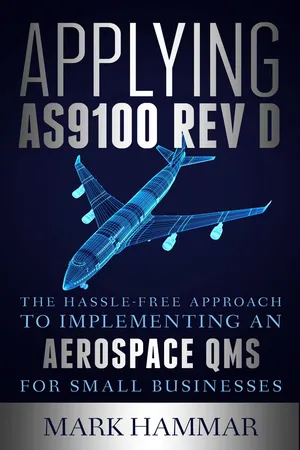
Applying AS9100 Rev D
The Hassle-Free Approach to Implementing an Aerospace QMS for Small Businesses
- English
- ePUB (mobile friendly)
- Available on iOS & Android
Applying AS9100 Rev D
The Hassle-Free Approach to Implementing an Aerospace QMS for Small Businesses
About this book
Mark Hammar is an experienced Certified Manager of Quality/Organizational Excellence through the American Society for Quality. He has written this book to provide a comprehensive, step-by-step guide for AS9100 implementation, written in plain language, which can be understood by beginners with no prior knowledge of the standard. The main goal of the book is to provide a systematic picture of what AS9100 Rev D is all about, and how to make sure you didn't forget something in your implementation. This book will explain how to use AS9100 Rev D as a framework, and to become fully compliant with this standard.
This book is written primarily for beginners in the field of QMS, and for people with moderate knowledge about AS9100. It is structured in such a way that someone with no prior experience or knowledge in the implementation of an aerospace QMS can quickly understand what it is about, and how to implement the whole project. If you do have experience with the standard but feel that you still have gaps in your knowledge, you'll also find this book very helpful. This book provides implementation examples in small- and medium-sized organizations (i.e. companies with up to 500 employees). All the principles described here, however, are also applicable to larger organizations. That means, if you work for a larger company, you might also find this book useful.
So, if you are a quality manager, a quality management professional, head of the quality department or a project manager who is tasked with implementing AS9100 Rev D in a small- or mid-sized company, this book is perfect for you. This book will also be quite useful for consultants, since it makes an effort to present information in the most logical way to implement an aerospace QMS. By carefully reading this book, you will gain the know-how for your future consulting engagements.
However, what you may find most helpful in this book is the practical examples and answers to real-life questions that come up when implementing AS9100. These bits of advice come from the author's experience both implementing AS9100, and from questions that he has been asked on a daily basis. After reading this book, you'll be able to implement the standard yourself, since it will provide you with enough knowledge and tips to implement the requirements in a small or mid-sized company.
Frequently asked questions
- Essential is ideal for learners and professionals who enjoy exploring a wide range of subjects. Access the Essential Library with 800,000+ trusted titles and best-sellers across business, personal growth, and the humanities. Includes unlimited reading time and Standard Read Aloud voice.
- Complete: Perfect for advanced learners and researchers needing full, unrestricted access. Unlock 1.4M+ books across hundreds of subjects, including academic and specialized titles. The Complete Plan also includes advanced features like Premium Read Aloud and Research Assistant.
Please note we cannot support devices running on iOS 13 and Android 7 or earlier. Learn more about using the app.
Information
1. INTRODUCTION
1.1 Why is AS9100 Rev D important within aerospace?
1.2 How is aerospace different?
1.3 AS9100 puts it all together
1.4 Who should read this book?
Table of contents
- ABOUT THE AUTHOR
- TABLE OF CONTENTS
- PREFACE
- ACKNOWLEDGEMENTS
- 1. INTRODUCTION
- 2. WHAT EXACTLY IS AS9100?
- 3. GETTING BUY-IN FROM YOUR MANAGEMENT AND OTHER EMPLOYEES
- 4. PREPARING FOR THE IMPLEMENTATION
- 5. FIRST STEPS IN THE PROCESS
- 6. THE BASICS: THINGS YOU NEED TO MAKE YOUR QMS WORK
- 7. UNDERSTANDING HOW YOUR QMS WILL FIT WITH YOUR COMPANY
- 8. THE DETAILS OF PLANNING FOR YOUR PRODUCTS AND SERVICES
- 9. IMPLEMENTING PRODUCTION AND SERVICE CONTROLS: OPERATIONAL PLANNING AND CONTROL
- 10. DAY-TO-DAY OPERATION OF THE QMS
- 11. MAKING SURE YOUR QMS WILL WORK AS EXPECTED
- 12. ENSURING YOUR COMPANY PASSES THE CERTIFICATION AUDIT
- 13. BONUS CHAPTER I: 12 STEPS FOR TRANSITIONING FROM AS9100 REV C TO REV D
- 14. BONUS CHAPTER II: RELATED STANDARDS AND FRAMEWORKS
- 15. GOOD LUCK!
- APPENDIX A – CHECKLIST OF MANDATORY DOCUMENTATION REQUIRED BY AS9100 REV D
- APPENDIX B – DIAGRAM OF AS9100 REV D IMPLEMENTATION
- APPENDIX C – INFOGRAPHIC: AS9100 REV C VS REV D – WHAT HAS CHANGED?
- APPENDIX D – SPECIAL TERMS IN AS9100 REV D
- GLOSSARY
- BIBLIOGRAPHY